Family : Oriolidae

Text © Dr. Gianfranco Colombo

English translation by Mario Beltramini
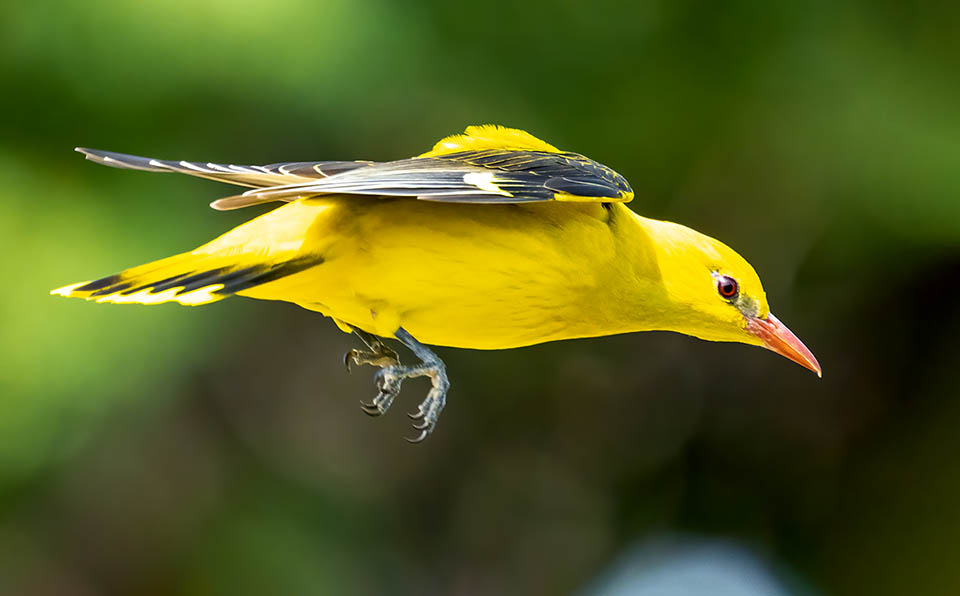
Tropical species reproducing in Europe in summer, when fruit abounds, the Golden oriole (Oriolus oriolus) is a bird uneasy to observe © Davide D’Amico
In the environment where we live, the nature and the colours do not always highlight that variety and exaltation of shapes and colour shades that the tropical areas or the much coveted earthly paradises of the tropics offer to us, so the imagination is limited to these evaluations. We observe the nature documentaries shot in these pleasant places and every being shown us has by far, characteristics and beauties that we can’t find or at least we think so.
But reality often disproves this assumption! Even our Palearctic has its own wonders: try to observe a Eurasian Golden Oriole and you will get the proof!
To a hypothetical question posed to anyone, where such a bird could come from, by sure you should get a simple and trivial answer: it cannot live here with us!
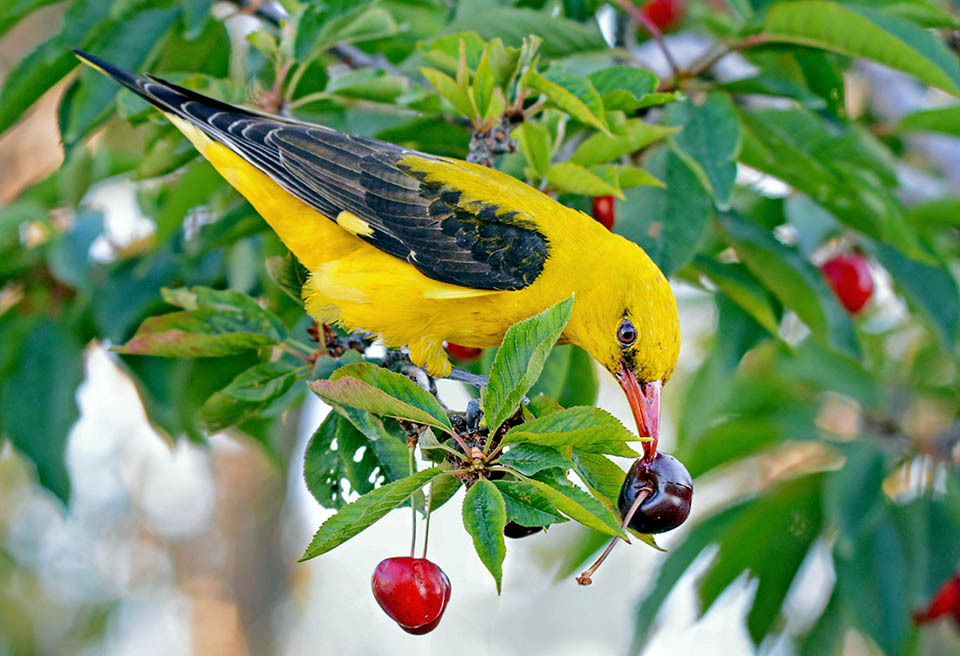
Fine connoisseur, here on a cherry tree, collects the first fruits. Only well ripe, sugary fruits, leaving the others for the next visits after having well memorized the place © Jesús Villaplana
It is surely coming from some tropical forest or it is a bird kept in captivity and escaped from some cage!
Indeed, something true stands in this answer, as this bird is an inhabitant of tropical forests but it comes up here every summer to nest among us.
The Golden Oriole (Oriolus oriolus (Linnaeus, 1758)) belongs to the order of the Passeriformes and to the family of the Oriolidae and is one of the most beautiful and eye-catching birds in our avifauna.
Practically, it is the only member of this family and of this genus present in our territory, as the other members of this grouping are typically birds living in the dense tropical rainforests and in the equatorial climates.
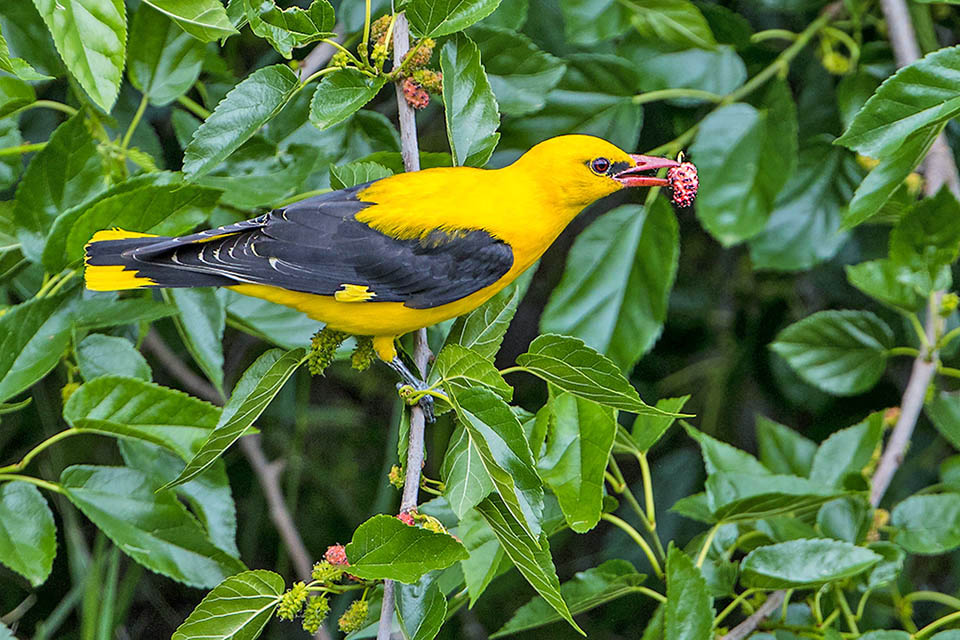
Same behaviour on a mulberry looking for the best berries. Despite the size and the colour we notice its presence only because of it characteristic flute song © Henrique Oliveira Pires
Very few are those who have had the opportunity of observing a Golden oriole in the wild, albeit gifted of dazzling colours to say the least!
It is one of the most shy and reserved birds and even when perched on the branches of the tree in front of you, would easily go unnoticed.
And to think that it is yellow like a lemon and has the size of a Blackbird (Turdus merula) !
Only clue of its presence is its flute-like song it insistently emits during the mating time; quite different from any other song we are used to and that we hear in our woods: a tropical sound, song that is not ours that makes us immediately understand that it is a bird from another world.
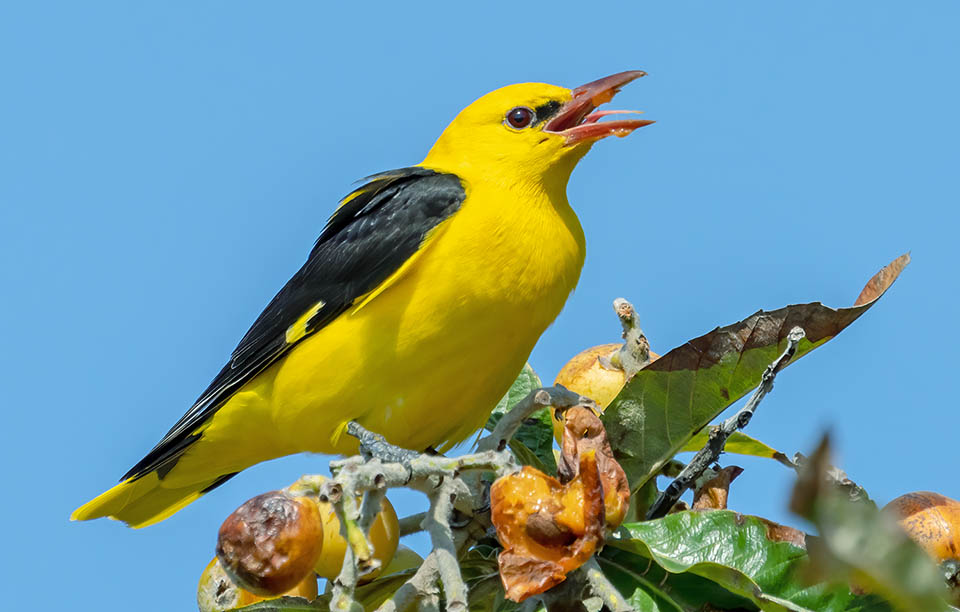
Maybe it’s late for the medlars but there are still few and devours them greedily. Actually the Golden oriole is an insectivore, but to return in Africa it must fill up in calories © Davide D’Amico
In the Lombard peasant tradition, this characteristic that in onomatopoeia repeats the sound of its song:
“Compare Piero, vieni all’osteria? Vengo anch’io vengo anch’io!”
But also in other Italian regions it is a custom to repeat the song with other messages:
“È già maturo il fico? No per Dio no per Dio!”
As well as in the European countries where it is common, like in Spain, where they have given it dozens of nicknames that imitate its song: “Mucho frio, pedroviejo“, or, combining it with its love for the fig, “Rodrigo, matura el higo?”
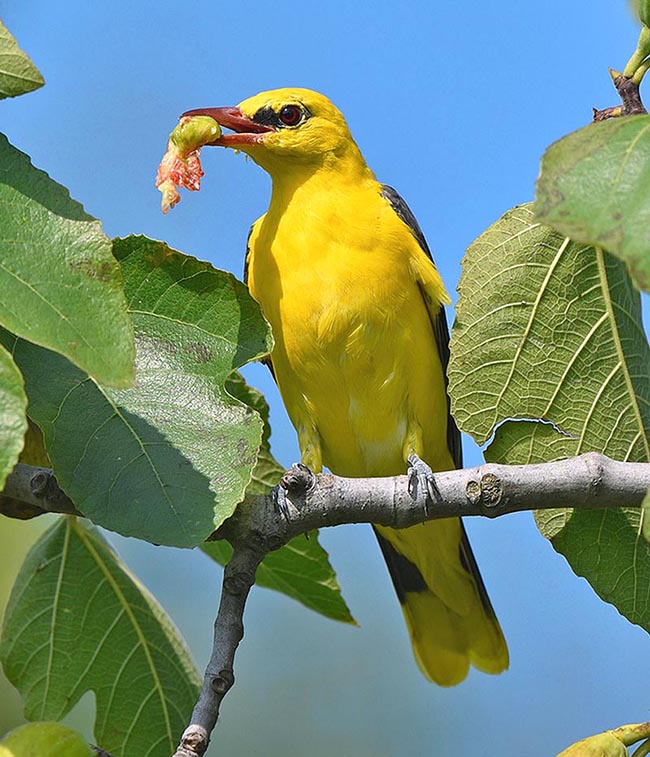
Figs are its choice fruits, as remind the vulgar names in various languages © Gianfranco Colombo
Also in France they often remember it with the nicknames that in various regions they have attributed to it: luôlio, didelio, Fidelio, or also … et voici le loriot.
Finally, in England where, though not widespread, playing on the well-known and ravenous gluttony for ripe fruits, they have invented a … is suitable for me?
Therefore, Europe has not missed the opportunity to remember it in proverbs and nicknames, as well as in poems and musical compositions.
This bird is by many generically and erroneously called Fig eater, as it is very greedy of the figs even if in reality the Garden warbler, in Italy the true fig eater (Sylvia borin), is a gay and a tiny small bird, belonging to the family of the Sylviids much smaller and quite modest in the colours but sharing the same passion for this sweet delight.
The vulgar names given to the Golden Oriole are many, amongst which some particular ones, even if often repetition of its song: galpèder, galvèder, gallopietro, comparepiero, beiora, goolo, rependolo and many others.
Rigogolo, the Italian name given to the Golden oriole is the result of transformations, truncations and bad transcription of the Latin name “auri galbulum” = having the colour of gold, whilst the etymology of the scientific binomen, Oriolus oriolus, repeated in the genus as well as in the species, takes up the Latin term “aureolus – aurum” = golden – gold.
It is surely a chance but there is no doubt that this bird’s name already highlights such an important feature so much to be compared to gold! International common names are: Eurasian Golden Oriole in English, Loriot d’Europe in French, Oropèndula Europea in Spanish, Pirol in German, Papa figos in Portuguese and a nice Nishikouraiuguisu in Japanese.
Zoogeography
Homeland of origin of this bird are the tropical areas of Africa, where it coexists with very similar congeners but that have maintained the character of residents instead of becoming long range migrants, like our Golden Oriole.
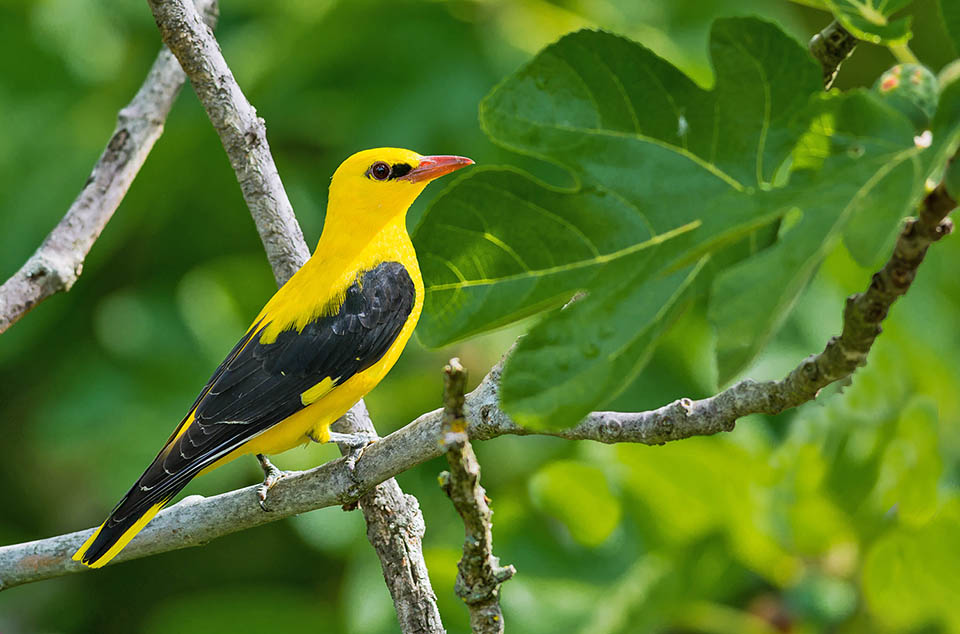
The male has a magnificent bright yellow colour in strong contrast with the wings’ velvet black. Typical, also compared to similar species, the black bar between bill and eye © Isabelle Cros – Quercy Animalier
It nests in all continental Europe up to the shores of the North Sea and of Baltic, reaching the southern coasts of Finland and through the trans-Ural Russia up to occupy the central Asian republics and to lightly touch the north-western Mongolia, in a belt limited by the sixtieth parallel north.
It is also present in Turkey and in Iraq, in the western part of Iran and in Africa along the Atlas Mountains, from Morocco to Algeria. It is completely absent in Iceland and in most of the Scandinavian peninsula as well as in the British islands where it is fairly rare.
All European populations and part of the Asian ones, diffusely spend the winter in austral Africa, occupying exclusively a very vast territory going from Central African Republic to South Africa. The populations of the extreme eastern range winter in India, south of the Himalayan chain.
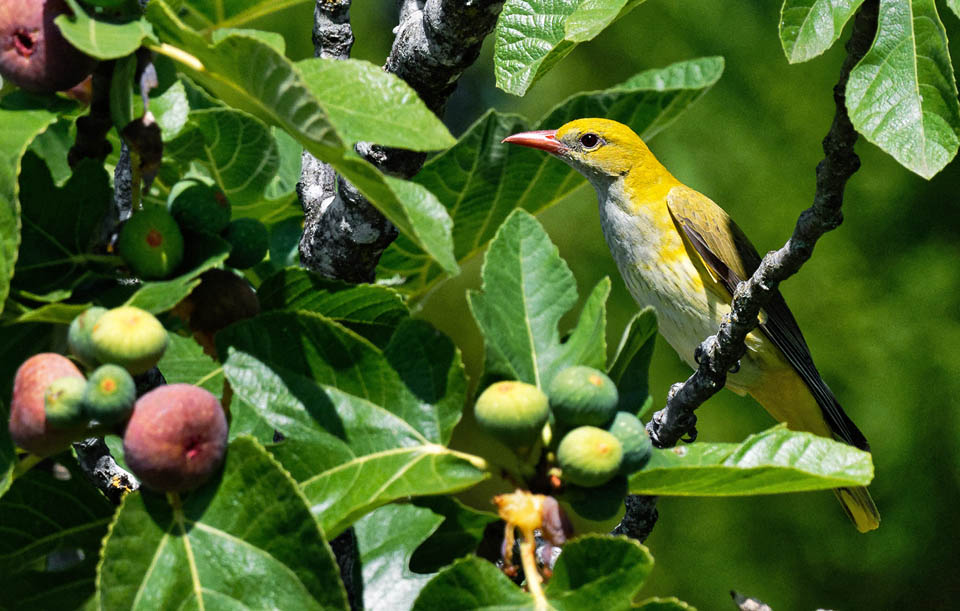
The olive-greenish females have a clear belly. The black bar near the eye is just hinted as well as other characteristics of the male livery © Isabelle Cros – Quercy Animalier
The very long migration towards the summer quarters begins in late spring and ends in the second half of May, at times, with delays until the first ten days of June: in fact it is one of the most laggard birds to conclude the migratory season.
It is just as quick to descend to the south, as already from late July and with maximum concentration in the month of August, goes back to its winter quarters.
Two subspecies have been described, broadly including the same populations that choose the two different wintering sites.
Oriolus oriolus oriolus, the subspecies wintering in Africa and Oriolus oriolus kundoo, the one spending the winter in India.
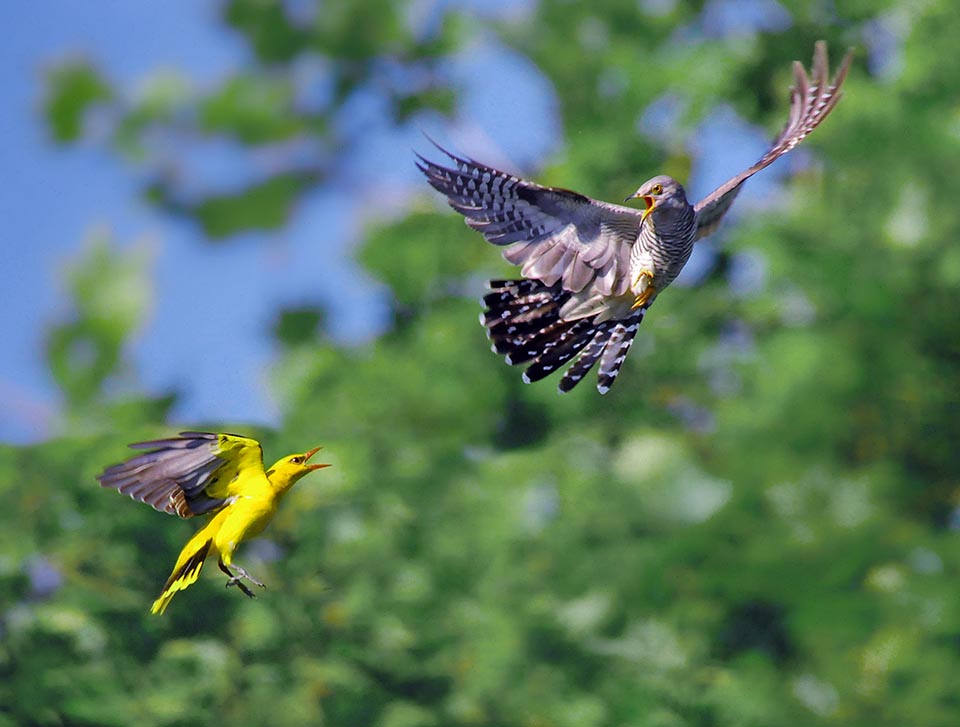
Males are territorial and gallant. Woe if a Cuckoo, a crow or another bird dares to enter the zone chosen for nesting © Agostino Codazzi
Ecology and Habitat
Tall leafy trees, dense deciduous forests and orchards with tall trees, represent the ideal environment for the Golden Oriole.
This bird rarely goes down to the ground and when this happens, it does it with a quick and unexpected twist only for collecting stealthily a big insect or a caterpillar seen from the branch where it was perched. However it would not be able to walk with ease, seeing that its legs are quite short and unsuitable for doing it.
The Golden Oriole spends all its life hidden among the dense foliage of the trees, on the higher branches and with dense foliage, rightly those high leaves that moved by the wind, are able to conceal with their waving and their variation of shades, the exciting and lively colours of its plumage.
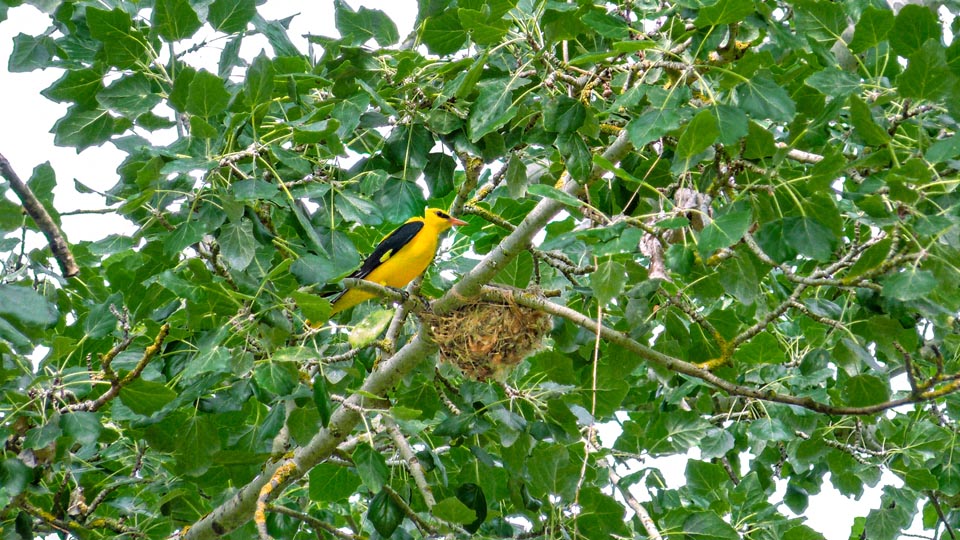
The nest is a solid cup built with blades of grass and fixed like a hammock on the fork of a branch. Wind resistant, it’s always placed high, even at 20 m from the soil © Pierandrea Brichetti
Let’s imagine it on a high plane tree that shows during the summer season, leaves of yellowish and hazelnut colour, mixed with others of a bright green and that moved by the breeze show their whitish pagina of that tomentum that characterized this plant and it, the male, very yellow, motionless while emitting its song and she, the green olive female, standing close to listen that sweet music.
Who would ever be able to see them?
Moreover, as we shall see, when it chooses the nesting site, it loves to do it close to a stream, coupling the gurgle of the brook to its own voice.
Only in the African winter quarters and partially in the Indian ones, the Golden oriole may accept some compromises.
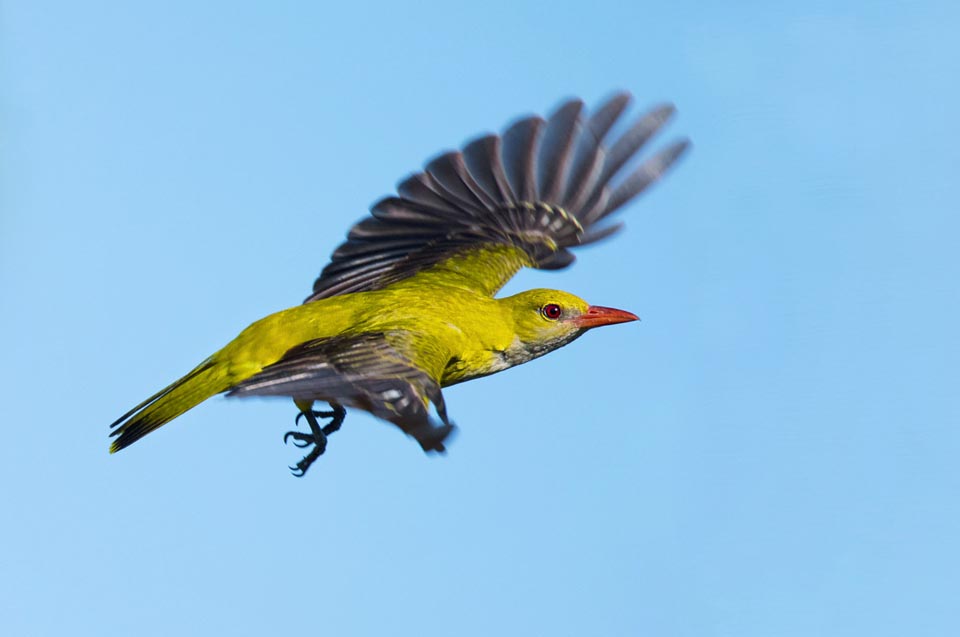
Male and female alternate hatching of 3-5 eggs. When they open it’s a continuous come and go looking for insects. Here a flying female © Jesús Villaplana
Here it may be found also in thorny thickets of acacia in the middle of the savanna or close to small villages, with four trees and some bushes, but when it discovers small corners of forest, with as well a small river crossing it, here it takes shelter immediately.
On the other hand, in these areas where to spend the winter, even if for its method of life, this period lasts a full eight months, during which it has to adapt in the best possible way and fight with the resident species for survival.
Morphophysiology
The Golden oriole displays a very evident sexual dimorphism with liveries so much distinct from each other to make an unwary person to think to two different species of birds.
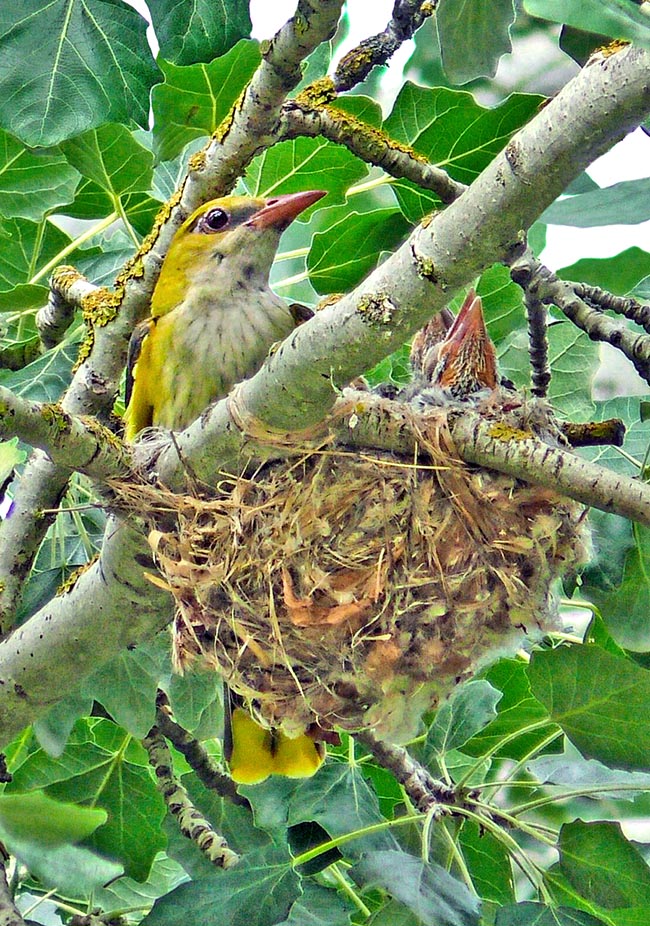
She is again in the nest, near the chicks just satiated © Pierandrea Brichetti
The male has the body, the head, the lower coverts of the wing and the back of a magnificent bright yellow colour, with shades that often aver different even between them. At times it is deep yellow and opaque, others of bright lemon colour and others more so clear to seem slightly faded and almost white.
Tonalities surely due to the age of the plumage, to the moment of the observation and, of course, to the different angle of sunlight.
It is however an unmistakable bird in the Palearctic.
Conversely, the alar covering and the tail are velvety black in stark contrast with the colour of the body.
On the wings it shows a short bar of the same yellow, placed at the height of the remiges in correspondence with the first primary coverts, always well visible when perched.
The lower face of the remiges is instead clearer, of a greenish ash colour.
On both sides of the head it has a small black bar that from the bill gets to touch the ocular globe, forming a small mask, also always well visible.
On the tail, on the terminal part of the outer rectrices, are present some yellow dots forming an evident and characteristic drawing.
The bill is orange, robust and strong, very pointed and the very black legs with toes typical of an arboreal bird.
The eyes are crimson in colour, with a more or less marked red depending on the age of the individual.
Conversely, the females are completely greenish and olivaceous on the upper part of the body and on the alar covering and whitish, with yellowish shades on the sides, with some references reflecting the livery of the male albeit in a rather attenuated way such as the small yellowish barring on the shoulders, the black livery near the eye, the bill slightly orange and the characteristic yellow black pattern on the tail.
The young are rather similar to the adult female and display, as only diversity, a strong black dotting on the greyish chest.
The adult livery is acquired after the second year but is very complex and articulated so often can get rather different interpretations about the age of the observed subjects.
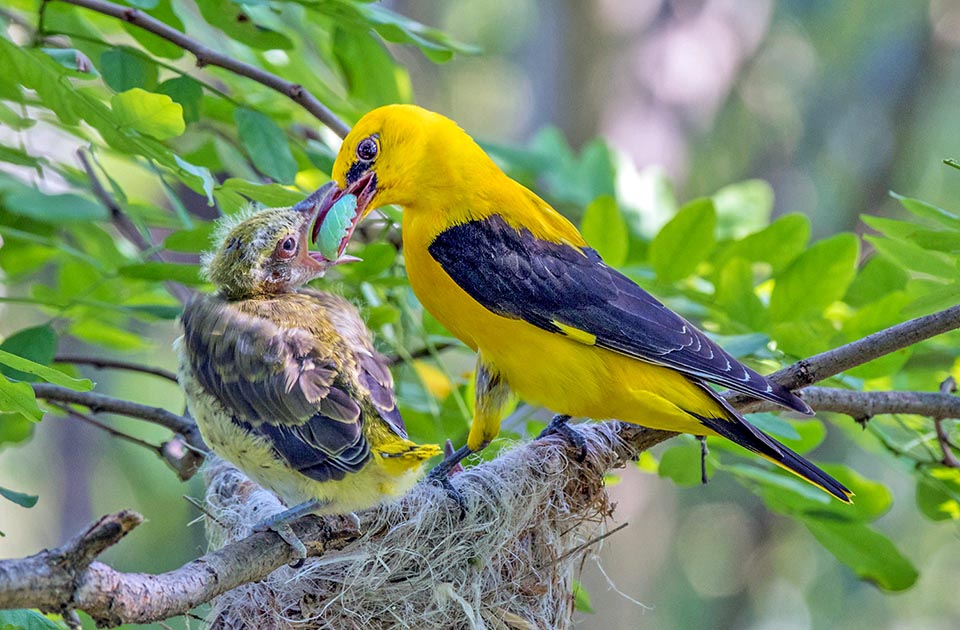
This male has found a big caterpillar of the Poplar hawkmoth (Laothoe populi) offering a chick already able to scamper on the branches © Bea Torok
When flying it shows characteristics fairly similar to big turdids, with a fast pace, rapid wing beats, light glides and a moderate undulation.
In the winter quarters our Golden oriole meets very similar species and often, given the elusive nature, very mistakeable to each other.
In Africa it lives together with Oriolus larvatus, Oriolus percivali, Oriolus brachyrhynchus, Oriolus nigripennis, Oriolus clorocephalus and Oriolus auratus, whilst in India with Oriolus xanthonotus, Oriolus tenuirostris and Oriolus chinensis, the latter being incredibly like our species.
The Golden oriole is 23 cm long, with a weight varying from 50 to 80 g and a wingspan of about 45 cm.
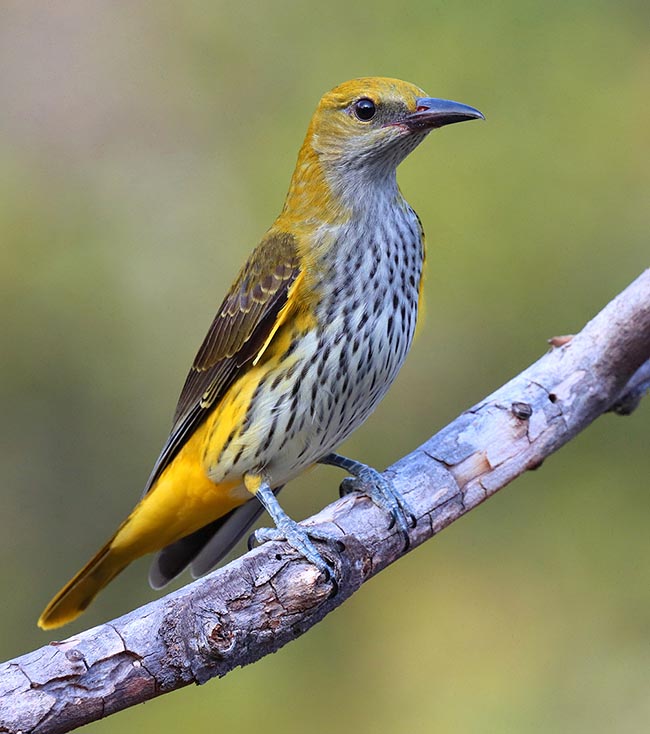
Young male. The livery looks a lot like that of the adult females, but the yellow is marked and the bill is blackish © Miguel Angel Hernansanz Galan
Reproductive Biology
If the Golden oriole is already very shy and reserved in its normal daily activities, it becomes even more so during the nesting period.
Furthermore, such is the grace of its song and such is the beauty of its livery, as is the incredible architecture of its nest!
First of all, the choice and the location of this work of art: the Golden Oriole places its nest at often dizzying heights for a bird of its size.
It loves the rows of trees standing on the edge of the woods, preferably the first rear lines from the borders and possibly close to small streams. The preferences go for the deciduous trees but in the northern part of its range it does not disdain the use of conifers or of evergreen essences at times also in small isolated thickets.
There is not a prefixed height where to place the nest but the same is always built averagely very high above the ground, at times even exceeding the 20 m.
Usually it is built on the terminal part of the branches demonstrating that this bird definitely is not suffering from voidness, least of all from the shaking to which these branches are subject.
Practically, the nest is a hammock suspended in the void and literally supported and stitched around two horizontal small sprigs of a fork of the branch.
Are used very fine and resistant blades of grass and with patience tied and wrapped, first to a sprigs, then to the other giving the appropriate curvature to the cup of the nest.
A complex operation performed by both sexes but mainly by the male who appears to be the most able in this first phase of construction.
One after the other, the threads are sown on the two branchlets to form the supporting structure of the nest, in which are then inserted, mostly by the female, vegetable materials, feathers, wool, hairs of animals, cobwebs and vegetable cotton, up to form a comfortable and soft cup.
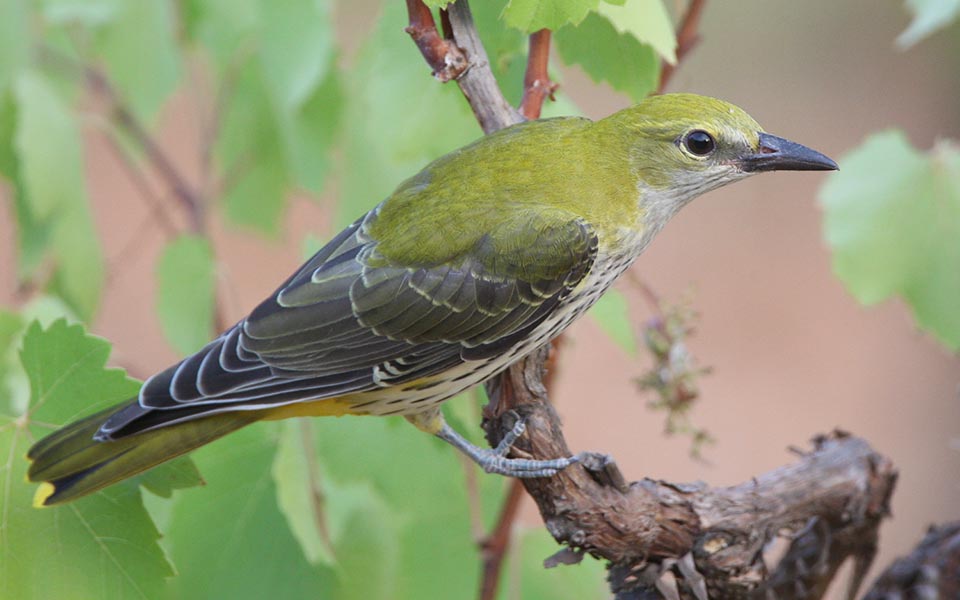
Due to the dark bill, even if the livery is quite similar to the adult’s one, we at once understand also here that it’s a growing female © José Paulo Diogo
The nest is small in its structure, an only about ten centimetres hollow, maybe narrow for this small bird but it is guaranteed by an incredibly strong hold and a resistance such as to make it overcome the winter bad weathers. As a matter of fact it has been observed that in the construction of new nests, it is frequently used the material of old accommodations as demonstration of how resistant is the stuff being used.
Only in winter, when all trees are bare, can be noted, up there, many metres above the ground, these unbelievable constructions realized with an anomalous tool such as a bird’s beak.
3 to 5 eggs are laid, clearly tapered, of whitish colour with pink halos, lightly marked by dark dots, that are hatched by both partners for about two weeks. At birth the nestlings are cared for and nourished by both parents for two weeks more until they are able to fly.
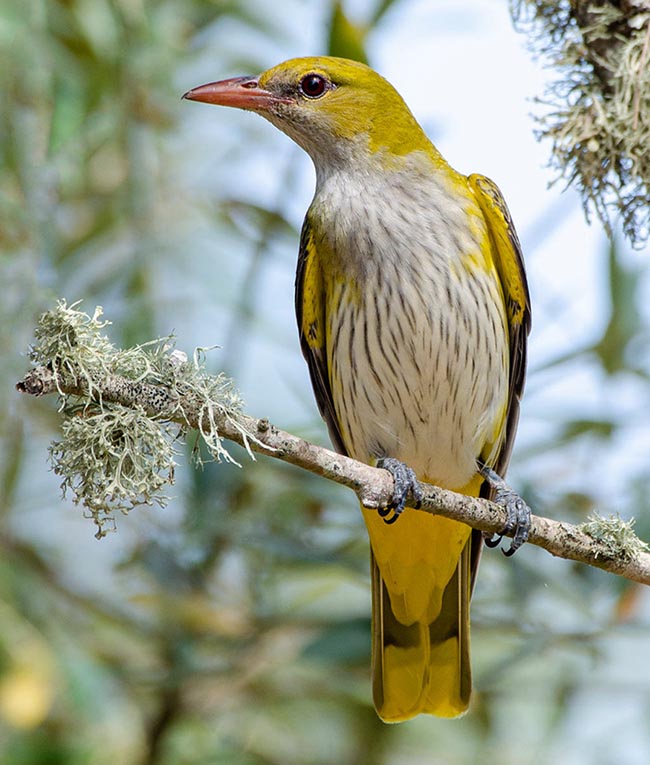
Subadult female. It has almost the final livery, apart from the hatching on the chest gradually fading with the age © Luis Costa
Such a highly positioned nest and on extremely flexible branches, can be the cause of accidental falls that would be fatal for the chicks.
Serious as well is the threat of the crows that, even if strenuously hindered by the parents who display unbelievable courage and persistence, often manage to rob in the nest, when they attack in numerous groups the poor small birds.
The Golden Orioles are insectivores for most of the year and especially during the nesting period. They mainly eat lepidopterans and their larvae, chrysalises and hymenopterans but also small rodents and molluscs.
Once the nesting period is over, there is a drastic modification in the feeding of the Golden oriole. The necessity of storing fat for the long way back that will lead it thousands of kilometres far away, directs it on highly caloric foods such as highly sugary fruits that coincidentally ripen in this same season.
So, here the fig, the elderberry, the blackberries and other fruits, become the main food in this period, with solid bellyfulls that lead to rapid fattening.
The Golden Oriole is not considered an endangered species even if it is subject to inconsiderate drawings done by illegal hunters located along one of the main ways of their migration.
In the Middle East, with Turkey, Cyprus, Lebanon, Arab Emirates and Egypt, a real barrier is created that causes an incredible massacre of these birds.
Nets, traps and guns, in defiance of international laws concerning the tutelage of the protected species, make slaughters of this bird making it a coveted prey that feeds a thriving business.
It is inconceivable and unacceptable that an animal amply protected in all the European continent, guarded by extremely rigid laws guaranteeing its survival and well-being, badly end its life in the hands of such individuals.
Synonyms
Coracias oriolus Linnaeus, 1758.
→ To appreciate the biodiversity within PASSERIFORMES please click here.
